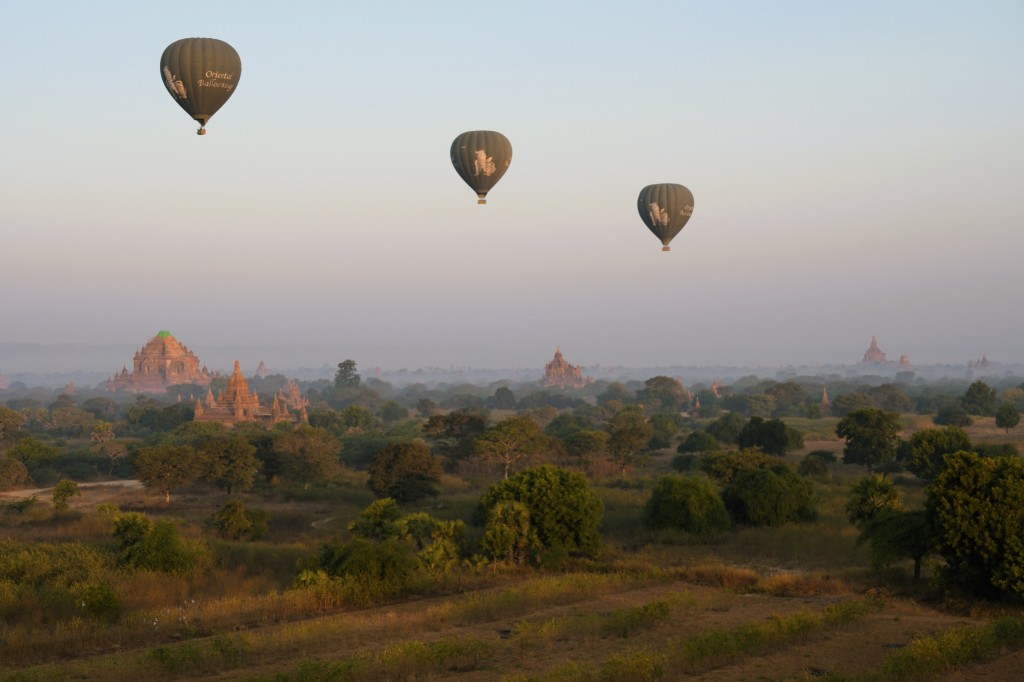
I can’t deny it. I’m a tourist in Bagan, Myanmar.
The Bagan Tour Guide Association estimates that there were 250,000 tourists in 2015. The Myanmar Ministry of Hotels and Tourism estimates that 4.68 million tourists in 2014 spent over 1.8 billion US dollars. I am one of those tourists who spends money.
Using Oriental Ballooning, I and probably 45 others became some of the most recent supporters of Bagan’s economy. Despite the cost, the 6:50 AM balloon ride was amazing. I can’t imagine flying over an archaeological site anywhere else in the world. We did here though!
The morning started in the dark at 5:50. Saying hello, I jump into an almost full pick-up van. Within minutes we are at a vacant field next to a resort’s golf course (owned by the military probably). We sit briefly at tables covered in cloth tablecloths enjoying coffee and croissants. My three tablemates are from Chili. The two parents are riding s balloon, but their eleven-year old son is too small so he’ll ride with a ground crew truck to the eventual landing site. He’s happy since he is still missing school.
A person greets us in British English. “Good morning. Welcome to Oriental Ballooning.” “Each pilot of a balloon will introduce themselves and read the names of those in his or her balloon.” As each pilot reads the eight names on the list, I begin to wonder if this is a UK company. All the pilots seem to speak with the same British English. While there is one woman pilot, I join Matt who has a wife and two kids in the UK. He has flown in Bagan for three years; prior to Bagan, he flew in Italy. It is an “American” balloon. A couple is from Ohio; a couple is from Texas; two young Indian-Americans speak American English; and Sarika, a young woman who was Kolkata born but is now a New York City architect.
There are basially three baskets. Matt controls the balloon from a central basket which also holds the gas cannisters. The central basket is surrounded by two other baskets each of which is divided in two. Two of us share each of these smaller spaces which are about 3’by 3’. It is nice and cozy.
Matt quickly gives us some rules. “No smoking, not even E-smoking.” Duh. “No pulling on the ropes that control the balloon.” Duh. “No grabbing the gas line hoses.” Duh. “Anything that falls out of the baskets is gone.” Duh. He quickly briefs us on the all important take-off and landing positions. We are to sit on a small bench placing cameras between our legs and holding onto the grab handles. Easy enough! After inelegantly climbing into the tall baskets, we are airborne within minutes.

The view is amazing. The sun is slowly rising. In every direction, we see pagodas, pagodas, and more pagodas. The vastness of the area where there are pagodas reminds me of Cambodia’s Angor Wat. The numbers of pagodas vary. Some say that there are around 2500; others say that there were as many as 3,000 to 4,000. Some pagodas are large reaching almost 200 feet; other pagodas are small being barely 10 feet tall. The placement seems to be random, almost like a reseeding of a fescue grass yard in September. Some pagodas cluster closely together here; a lone pagoda stands by itself in the distance; another major pagoda is surrounded by much smaller pagodas over there. As one woman says “If you visit Bagan it is hard to miss a pagoda.” Looking into the sunrise, we see the silhouettes of pagodas surrounded by the ground haze. Looking away from the sun, we begin to see the soft morning light on the orangish and reddish pagoda brickwork. Beautiful

Scholars estimate that the pagodas were built between 1044-1287 when Bagan became the first capital of Myanmar. During this period, the kings began to favor Theravada Buddhism over forms of Hinduism or Mahayana Buddhism. As they built the Buddhist pagodas, they evolved the architecture. Some were solid stupas; others were hollow pagodas holding Buddha statues. Some scholars speculate that with the Mughal invasion of India, many skilled craftsmen moved to Bagan. They found opportunity just as skilled people today move around the world to use those abilities. Since Bagan lies on a fault line between the India and Burma plates, it has experienced many earthquakes. From 1904 to 1975, Bagan recorded 400 earthquakes. The July 8, 1975 registered 6.5 magnitude and destroyed several hundred pagodas; the August 25, 2016 earthquake also destroyed or closed several other pagodas. It is probably amazing that there are still as many pagodas as there are!

We fly at 7 mph. There are twenty balloons total with Oriental Ballooning flying six of the balloons. The original company to be granted permission, Balloons over Bagan, flies twelve balloons. Matt gently fires the gas rotating our balloon so that we have various views. Except for when he uses the gas, there is not a single sound. Like me, I suspect everybody is in silent awe at the sights below us. It is like viewing from above Canterbury, York, Westminster, St.Paul Cathedrals all at one time.


Matt begins to navigate our landing by coordinating with others the landing site. Speaking from experience, Matt exclaims: “Once you commit to a landing site, you are committed!” The Oriental Ballooning balloons try to land close together. Although each balloon has 10 ground crew members per balloon, it is easier for the ground crews and safer for the passengers when all the balloons land close together. Of course, that doesn’t always happen! We land with a soft “thud” and a tilting of the basket as the balloon slowly continues to drift. The ground crew grabs ropes and hangs onto the sides of the basket to bring us to a complete halt.
The morning isn’t finished though. Because the first French ballooner in 1785 carried a bottle of champagne to give to the French farmer whose field he landed in so that he could show that he came as a friend and not a foe, Matt popped open a bottle of champagne for the eight of us. Great champagne!
I played the tourist. I am the tourist. Would I do it again? You bet!


Good morning, Curt, at least it is here. Could be midnight for you. We’re in class and showing your blog. No pressure, but hopefully we will have you up at least every Sunday. So post as you deem best. In any event, stay safe and take care of yourself and Mary.
Christian Families Class
LikeLike
Love hearing about your adventure and seeing these awesome pictures, Curt!
Susan
LikeLike